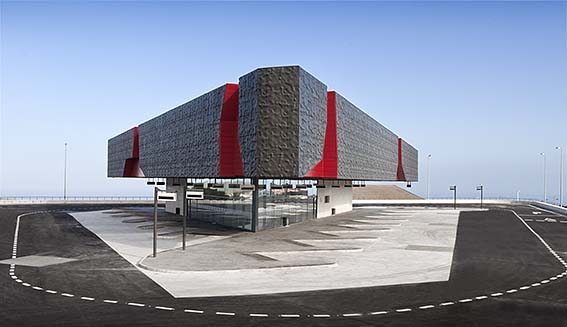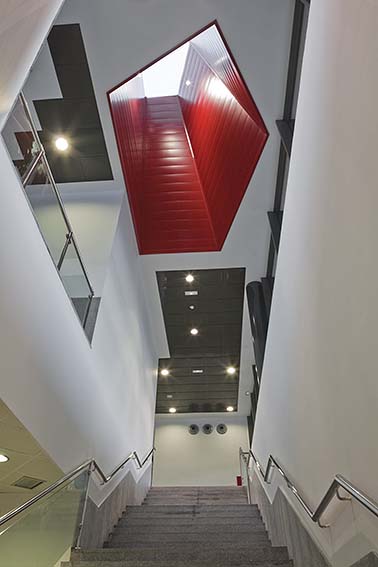I sat down to write this article on the second official day of the British summer. As such, I looked out from my desk to see leaden skies and hear the hissing of the summer rain. At that point I decided it was time The Beauty of Transport headed somewhere with more reliably hot weather. So this week, we’re off to the Canary Islands, and Tenerife in particular.
There’s a splendid moment in 1996 summer blockbuster / super-sized B-movie / guilty pleasure Independence Day (dir. Roland Emmerich) in which huge alien spacecraft hove into view above the world’s major cities. These vast ships have intricately detailed surfaces, and hover impassively in the sky.
A rather similar sensation can be obtained in the realm of public transport at El Intercambiador de Transportes de La Laguna (although I’ve also seen it called Intercambiador Padre Anchieta, a name shared with the nearby tram stop). For English readers, that would translate into something like La Laguna Transport Interchange, or just La Laguna Interchange. Unfortunately, despite its aesthetic qualities, it’s not much photographed, possibly because of its location on an island, and there are even fewer photos of it that are licensed for re-use. So here’s a Google Street View image of it to start with:
The triangular monolith of the bus station’s roof gives every impression of simply floating over the heart of the bus station. The textured, stone-like, black exterior finish is incised at apparently random points by angular cuts. These incisions are finished in smooth red tiling, giving the impression of exposing whatever lies beneath the monolith’s crinkly outer layer. You can also read it as a representation of the volcanic nature of the Canary Islands – black solidified lava with red-hot magma lurking underneath.

The effect of a huge object hovering overhead is achieved by the use of extensive slender glass walls on the ground floor, on which the monolithic roof appears to float. There’s a really nice selection of images of the bus station on this flickr gallery. I’d highly recommend checking it out to see why I’m so enthusiastic about this building.
Underneath the bus station is a covered car park, built into the slope of a hill, the flat roof of the car park forming the platform on which the bus station building and bus bays are located. The stairs up from the car park lead into the part of the bus station building which has solid walls (in plan, the wide east end of the triangular building).

Intercambiador de Transportes de la Laguna is a cracking piece of transport design, not really like anything else that I’ve ever seen. It’s bright and modern at the same time as being dark and pensive, small but with a big impact. There’s nothing inside the upper section apart from a lattice of metalwork to support the exterior shell (there’s a nice diagram on CAD engineering firm Osome’s website here). The remaining details – benches, realtime information displays and the like – are neat, functional, and minimalist, hardly intruding into the overall visual effect.
![The official opening of Intercambiador de transportes de La Laguna on 24 March 2011. President of the Canary Islands government Ricardo Melchior is at the lectern. Despite the assembled dignitaries trying to get in the way, this photo gives a great view of the detailing of the roof structure. Photo by www.acfipress.com [CC BY 2.0] via this flickr page](https://thebeautyoftransport.com/wp-content/uploads/2015/06/5556780690_b307c941fe_z.jpg?w=400&h=601)
I wish I was the first person to be reminded of an alien spacecraft by this bus station. However, once you go looking, you’ll find that practically every mention of it on the internet is accompanied by a note on its similarity to alien hardware. What can I say? Great minds think alike, or fools never differ…
Puncturing the roof element are various polygonal holes cut vertically through the structure. These skylights ensure that despite the mass of overhead structure, it’s not too dark underneath. Mind you, given Tenerife’s climate, I’m sure that any shadows cast by the building are very much welcomed by waiting passengers during summer months. The skylights are also fabulously artistic sculptural elements (see this picture).
The bus station opened in 2011, replacing the older San Benito bus station. That one was a queasy Postmodern building, which was situated a few hundred metres up the TF-5 motorway at the next junction, and which appeared to come straight from the Toyland book of transport design.

El Intercambiador de Transportes de La Laguna cost a cool €6.7m¹. But look what you get for your money: something that not only does its job, but enhances the local built environment and raises the profile and apparent quality of island bus operator TITSA. It’s a high-quality invitation to sample public transport, lending the whole TITSA network dynamism and excitement.
The bus station was designed by Canary Islands-based architect Eustaquio Martínez. I’d love to be able to direct you to the relevant page of his website and tell you what he says about the project, but unfortunately it’s not featured there. What you can find is this, an earlier proposal to rebuild San Benito bus station before the decision was taken to build on a new site. Contained in this earlier design are the emerging ideas which made it through to El Intercambiador de Transportes de La Laguna: the triangular plan (imposed in both cases by the sites involved), a heavy roof floating on glass walls, and skylights puncturing the roof structure to bring light down to the ground.
Martínez has worked on other projects with local bus operator TITSA, including one of its major depots at Cuevas Blancas, one of the more aesthetically pleasing structures of its sort. You can see some images of it on TITSA’s website, here, and on Martínez’s website here.
How to find El Intercambiador de Transportes de La Laguna
Click here for The Beauty of Transport map
Further reading
¹Press release from civil engineer consultancy Teno Ingenieros covering the opening of the bus station, here
Postscript 9 September 2015
It took a while but I finally tracked down some photos of the interchange which the photographer gave me permission to reproduce, so some photos have been added compared to the original version of this article. Many thanks to Jose Ramón Oller González for letting me use his pictures.